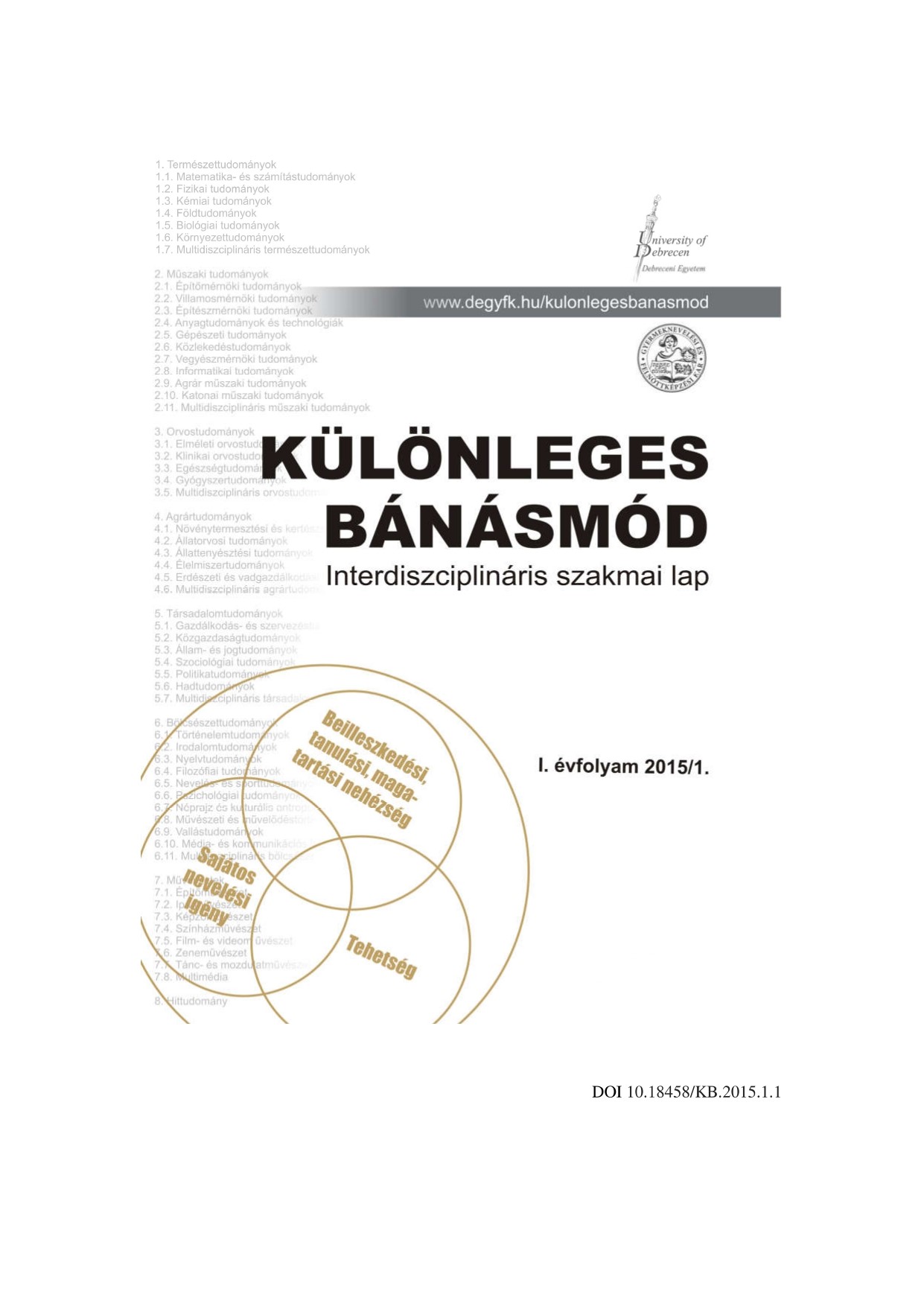Vol. 1 No. 1 (2015)
##issue.tableOfContents##
Articles
-
Greeting
5Views:105Welcome to among Readers, Authors, and Lecturers of the Special Treatment interdisciplinary professional journal!
-
SPECIAL TREATMENT, 2015. Vol. 1. (1.)
1-108Views:220This is the full text of 2015/1 of the Journal of Különleges Bánásmód /Special Treatment/.
PDF (Hungarian)236
Empirical and Essay Studies
-
REFORMING THE TEACHER TRAINING OF THOSE WHO WORK WITH CHILDREN WITH SPECAIL EDUCATIONAL NEEDS IN DEBRECEN AND SZEGED INSTITUTIONS
7-24Views:152This study summarizes the work and significance of Dr. Sándor Náray-Szabó, who was the founder of the Hungarian special education in the 20th. century. At the end of the 19th century, Náray-Szabó (1861-1914) recognized social opportunities, and he worked in order to reform schools and the teacher training of disabled people. He was one of the founders of the modern Hungarian education system for those with special educational needs.
pdf (Hungarian)139 -
TEACHERS OF CHILDREN WITH SPECIAL EDUCATIONAL NEEDS: WHERE WE ARE COMING FROM AND WHERE WE ARE GOING TO?
25-40Views:173In this article, we focus on special educational needs teacher training, geographical differences, and labor market features. Sources are the admission database of 2014, n = 965), and the Hungarian Graduate Tracking System (HGTS) of 2012 and 2013; n = 567). Result: the situation of special education teachers is very good in the labor market, they are very successful because their unemployment rate is lower than average, and their job is in connection with their university studies.
pdf (Hungarian)357 -
THE SHAPING OF PSYCHOMETRIC CREATIVITY AMONGST SECONDAY GRAMMAR SCHOOL STUDENTS IN A FOUR YEAR LONGITUDINAL STUDY
41-53Views:161In this study, we analyze the test-retest reliability of psychometric creativity tests and their connection with intelligence. Sample: n =107 (males: 66; females: 41) secondary grammar school students. Method: in the year 2011 we applied the verbal Unusual Uses and the figural Circles creativity tests, and (as an additional test) the APM intelligence test, and we repeated these examinations in 2014. Results: there are moderate correlations between pre-and posttests (after four years) in the cases of creativity tests (rs = 0,30-0,51) and intelligence test (r = 0,53), too. The students with higher pre-test scores will probably have higher score differences between pre- and post-test than the students with lower pre-test scores (rs = 0,28-0,57).
pdf (Hungarian)169 -
FORMS OF AGGRESSION IN SCHOOLS AS DETERMINING FACTORS IN GAINING SOCIAL STATUS IN A SCHOOL GROUP
55-66Views:193In our study, we have focused on the relationship between certain types of aggression and the sociometric status of primary school children, considering the effect of these factors on the hostile character of cognitions that aggressive children generate towards their peers. Sample: Our sample consisted of 321 primary school children from Transylvania (M=10.25 years, SD= 0.71), out of which 61.4% were of Romanian and 36.8% of Hungarian ethnicity. Method: our instruments measured the type of aggression, the sociometric status of children within the classroom, and the type of hostile cognitions towards peers. Results: gender differences and sociometric status has an effect on types of aggressive behavior. The results are useable in the field for prevention and intervention.
pdf (Hungarian)441
Methodological Studies
-
BASIC TERMS IN MATHEMATICAL STATISTICS OF IMPACT STUDIES FOR DEVELOPMENTAL PROGRAMS
69-77Views:177Pedagogues, kindergarten pedagogues, special needs teachers (also known as remedial teachers), and psychologists – just a few of those people who can create and use development programs. These programs are expected to be proven in their effects by using mathematical analysis. However, it doesn’t happen in every case – partly due to a shortage of definitions of mathematical statistics, methodology problems, and expensive software. This paper is a theoretical summary of the mathematical-statistical analysis of effectiveness studies of remedial courses designed for those who live with special needs.
pdf (Hungarian)131 -
SPECIAL TREATMENT IN HORSE ASSISTED EXERCISE
79-89Views:271According to decision No. 1061/2012 (III.12), the Hungarian Government is dedicated to National Equestrian Programme. Riding has been an optional subject in the frame of everyday physical education for all schoolchildren in 3-4-5 classes in Hungary since September 2013. The present study gives an overview of different types of horse activities focusing on approaches that are extremely suitable for teachers, trainers, therapists, and other specialists in the course of educational, pedagogical, and developmental improvement of children. The presentation of methodology is complemented by case studies.
pdf (Hungarian)417
Workshop descriptions
-
THE INTRODUCTION OF THE SPECIAL TREATMENT AND DIOGNOSTICAL RESEARCH CENTRE
91-98Views:195The ‘Special Treatment’ Diagnostical and Developmental Centre is a new research workshop of the Faculty of Child and Adult Education of the University of Debrecen. It was founded in 2015. This article shows the circumstances of founding, the main goals, the members and activities of this Centre.
pdf (Hungarian)169
Book Reviews
-
THE BOOK OF GYULA HATOS FOR THE PEOPLE WITH INTELLECTUAL DISABILITIES ON ITS LIFE CHANCES
101-102Views:237The reviewed book is:
Hatos Gyula (2012): Életkilátás-életkísérés értelmi akadályozottsággal élők körében. ELTE Bárczi Gusztáv Gyógypedagógiai Kar, Budapest. 325 oldal, ISBN: 978-963-7155-56-7pdf (Hungarian)225
Event Reports
-
REPORT ON THE I. SPECIAL TREATMENT INTERNATIONAL CONFERENCE
105-108Views:147Place: Debreceni Egyetem
Date: 2015. december 3.
pdf (Hungarian)109

